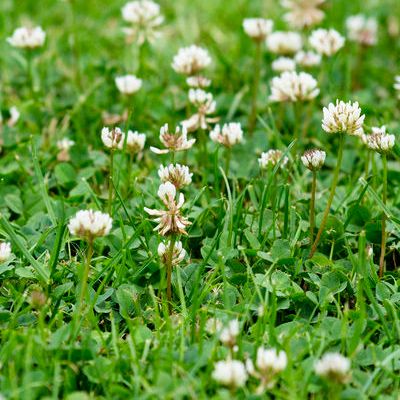White Clover

White Clover (Trifolium repens) is a long-lived perennial legume or winter annual legume. White Clover is a popular choice for systems that are “living mulch” and are planted between rows of irrigated vegetables, fruit bushes, and trees. It is also a forage species for livestock. Originating in Europe, it is now one of the most highly distributed legumes in the world. White Clover usually grows to about 6” – 12” high, but even when mowed or grazed, White Clover can thrive. Also, White Clover can hold up well under heavy field traffic. White Clover reproduces either by seed or vegetatively often forming colonies. Cool, moist conditions and shade help white clover flourish.
White Clover Foliage:
White Clover leaves are on a 1” – 3” stalk and composed of three leaflets which may include a “crescent” or “water mark” on the upper surface of the leaflet. The leaves are alternately attached and develop at the nodes along the stolon. White Clover leaves are about ½” in diameter and broadly oval to nearly round. They are rounded at the tip with a slight taper toward the base.
White Clover Flowers:
The flower heads of the White Clover consist of 40 to 100 florets on each flower head. The florets start out white but may turn a pink hue as they age. The round flower heads are about ½” wide with densely packed pea-shaped flowers that appear on a smooth, slender stalk. The stalks are about 3” long and appear perpendicular to the creeping horizontal stems that are ground level. The calyx tube that holds the flower has toothed lobes that are greenish white and hairless. White clover blooms between May and October.
White Clover Roots:
The White Clover root system has the ability to use its old brown roots to reproduce new roots in the spring. White Clover leaves and roots develop along the stolon at the nodes. This nodal root production helps ensure vegetative success because branch stolon growth will be more successful if roots are developed at the node.
Treatment for White Clover:
It may be more practical to manage white clover to a tolerable level rather than completely destroy the weed. An herbicide treatment is best if applied in the early fall.
Talk to an Adam’s Healthy Lawn Expert!
